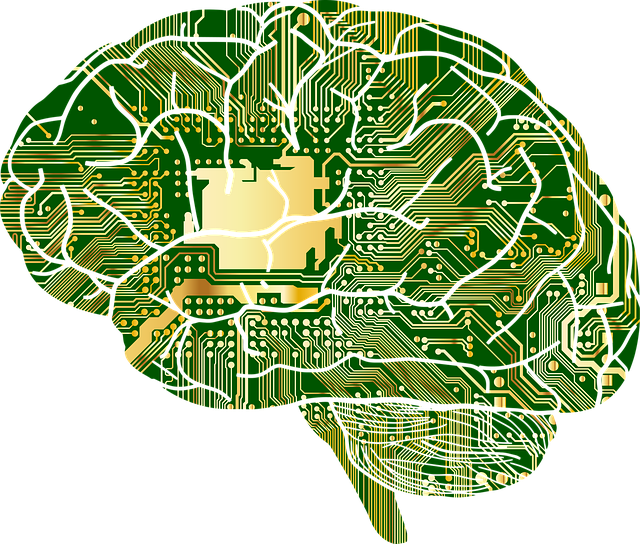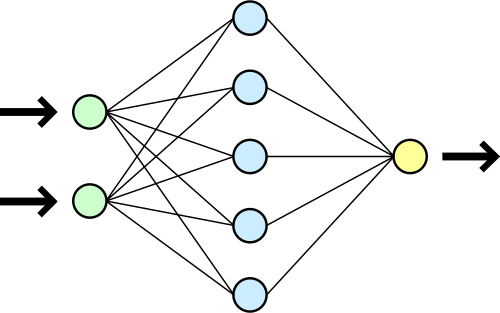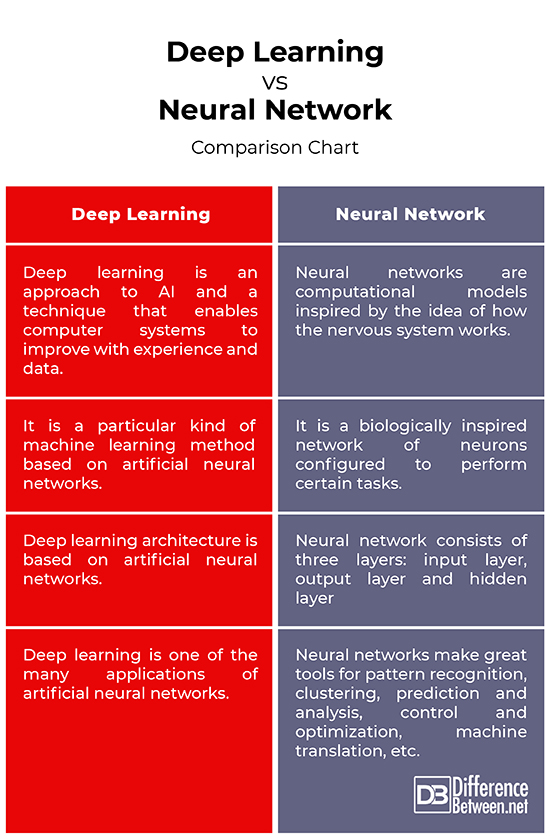Difference Between Deep Learning and Neural Network
As the digital era progresses, it is quickly becoming apparent that the then-technologies of the future like Artificial Intelligence (AI) and machine learning have radically changed the way we live our lives. They are not the technologies of the coming future anymore; in fact, we are now experiencing and witnessing AI on a daily basis, from smart digital assistants to smart search engine recommendations. The most prominent function of AI is probably deep learning. While the term was first associated with neural networks in 2000 by Igor Aizenberg, it has only become popular in the last few years. Deep learning is one of the hottest tech topics these days with corporations and start-ups rushing to have a piece of the pie. Deep learning is like a fuel to this digital era but without neural networks, there is no deep learning. So, to clarify, we will be discussing the two in detail and study their differences.
Deep Learning
With the reinvigoration of neural networks in the 2000s, deep learning has become an active area of research, paving the way for modern machine learning. Prior to this, this algorithm was called an artificial neural network (ANN). However, deep learning is much broader concept than artificial neural networks and includes several different areas of connected machines. Deep learning is an approach to AI and a technique that enables computer systems to improve with experience and data. It is a particular kind of machine learning method based on artificial neural networks that allows computers to do what comes naturally to humans. It is based on the idea of learning from example. Learning can be supervised and unsupervised. The idea is to build models that resemble the structures utilized by human brains. These algorithms surpass other kinds of machine learning algorithms.
Neural Network
Neural networks, also called artificial neural networks (ANN), are the foundation of deep learning technology based on the idea of how the nervous system operates. Everything humans do, every single memory they have and every action they take is controlled by the nervous system and at the heart of the nervous system is neurons. At its core, the neuron is optimized to receive information from other neurons, process this information and send the results to other cells much like the computer analog, the perceptron. A perceptron takes inputs, sums them all up, and passes them through an activation function, which then determines whether to send output and at what level. Perceptrons are inspired by neurons in human brain and are organized in layers which are made of interconnected nodes.
Difference between Deep Learning and Neural Network
Concept
– Neural network, also called artificial neural network, is an information processing model that stimulates the mechanism of learning biological organisms. It is inspired by the idea of how the nervous system operates. The nervous system contains cells which are referred to as neurons. Similarly, neural networks consist of nodes which mimic the biological function of neurons. Deep learning, on the other hand, is much broader concept than artificial neural networks and includes several different areas of connected machines. Deep learning is an approach to AI and a technique that enables computer systems to improve with experience and data.
Architecture
– Neural networks are simple architectural models based on how the nervous system works and are divided into single-layer and multi-layer neural networks. The simple instantiation of a neural network is also referred to as the perceptron. In the single-layer network, a set of inputs is mapped directly onto an output using generalized variation of a linear function. In multi-layer networks, as the name suggests, the neurons are arranged in layers, in which a layer of neutrons is sandwiched between the input layer and output layer, which is called the hidden layer. Deep learning architecture, on the other hand, is based on artificial neural networks.
Applications
– Neural networks allow modeling of non-linear processes, so they make great tools for solving several different problems such as classification, pattern recognition, clustering, prediction and analysis, control and optimization, machine translation, decision making, machine learning, deep learning and more. Deep learning models can be applied to various fields including speech recognition, natural language processing, self-driving vehicles, computer-aided diagnosis, voice assistant, sound creation, robotics, computer games, image recognition, brain cancer detection, social network filtering, pattern recognition, biomedicine, and more.
Deep Learning vs. Neural Network: Comparison Chart
Summary
In a nutshell, Deep learning is like a fuel to this digital era that has become an active area of research, paving the way for modern machine learning, but without neural networks, there is no deep learning. However, deep learning is much broader concept than artificial neural networks and includes several different areas of connected machines. Neural networks are the basic foundation of AI which helps implement deep learning. Neural networks, also called as artificial neural networks, are a set of algorithms modeled after the human brain and the nervous system. The simplest neural network is referred to as the perceptron, which is inspired by neurons in human brain.
- Difference Between Caucus and Primary - June 18, 2024
- Difference Between PPO and POS - May 30, 2024
- Difference Between RFID and NFC - May 28, 2024
Search DifferenceBetween.net :
Leave a Response
References :
[0]Aggarwal, Charu C. Neural Networks and Deep Learning. Berlin, Germany: Springer, 2018. Print
[1]Goodfellow, Ian, et al. Deep Learning. Cambridge, Massachusetts: MIT Press, 2016. Print
[2]Buduma, Nikhil and Nicholas Locascio. Fundamentals of Deep Learning. Sebastopol, California: O'Reilly Media, 2017. Print
[3]Image credit: https://commons.wikimedia.org/wiki/File:Deep_learning.png
[4]Image credit: https://upload.wikimedia.org/wikipedia/commons/thumb/3/3d/Neural_network.svg/500px-Neural_network.svg.png



